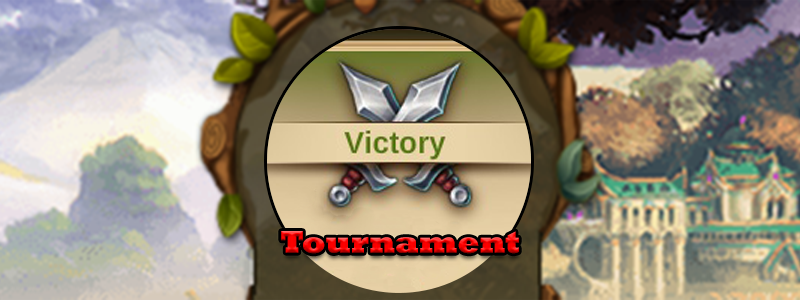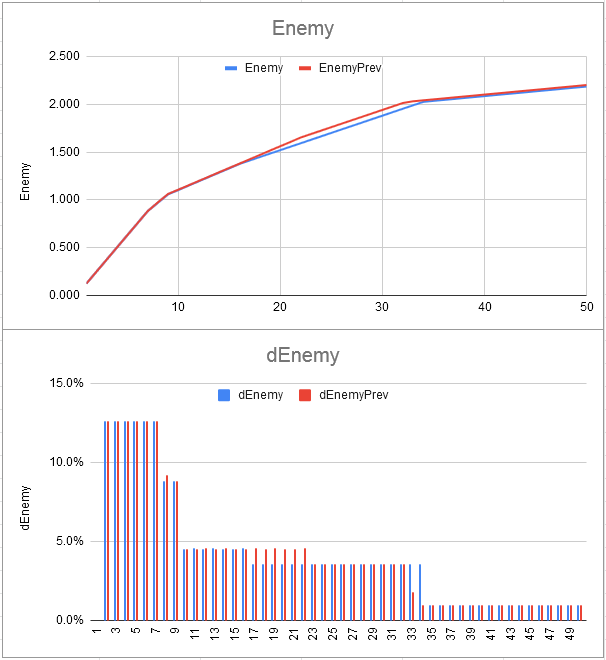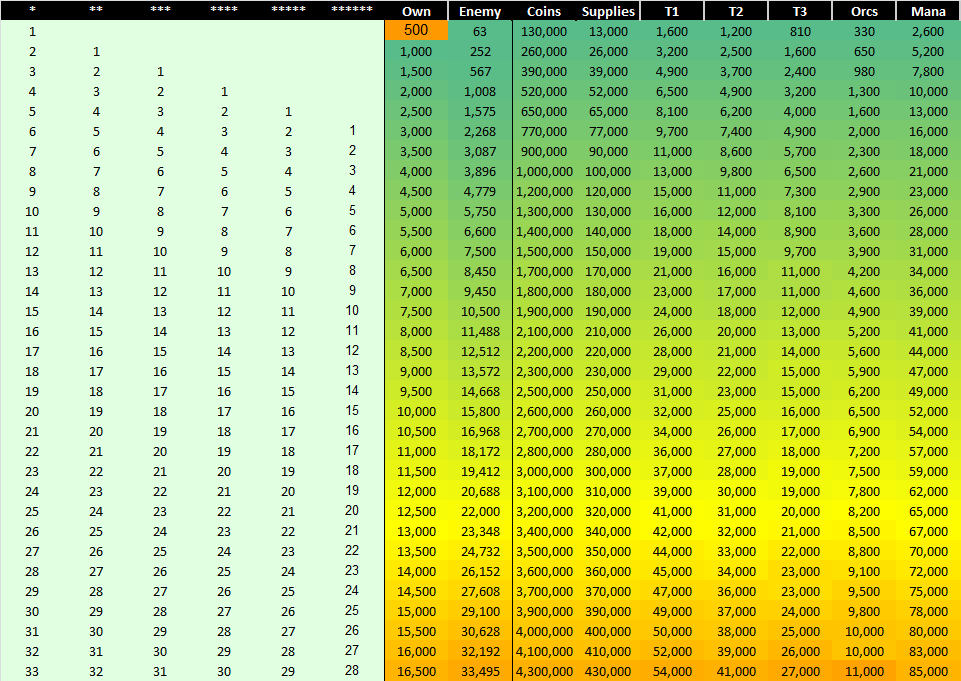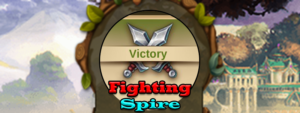[2020-09-29] Tournament Progression Model outlines how Tournament requirements – squad sizes and catering costs – evolve as you go further and do more provinces and stages (stars). There are some major changes being proposed to the tournament structure (Summer 2020), and this post outlines some of the parameters. Keep in mind that this is a work-in-progress at the moment, so all things here are subject to change.
Table of Contents
* – * – *
For a particular province number and stage (1*-6*) in the tournaments, enemy squad size always has the same ratio to your own squad size. And similar to that, your own squad size progression is also fixed. So all squad sizes in later provinces are completely determined by your own squad size at the very first 1* province encounter – which in turn is completely determined by CAL (City Advancement Level). And the same again goes for catering costs. Basically, once your weekly tournament is instantiated the whole setup can be represented by a single CAL number. Everything else will always be fixed with respect to that.
And just like with the Spire, once tournament has started, its parameters are fixed. Data snap time will still need to be confirmed, but so far it seems that it is different from the Spire’s. This means that if you make some changes between the Spire start and tournament start, it will be reflected in the weekly tournament progression, but not in the Spire (as it would be fixed by then).
Province Progression
And this is how province progression looks like (updated on 2020-08-26). Here it is:
This table is for 1* provinces. As you can see, your own Tournament squad size (TSSo) grows linearly, and province number N will have own SS equal to N times your base TSSo (1* province 1). The enemy SS factor is with respect to your own TSS in the same encounter – not with respect to the base TSSo! This means, say, in province 50, your enemies will have 2.2 times your own squad. This is not going to be pretty…
Enemy SS factors do not grow in a linear fashion, but rather step-wise. They start small, but grow very rapidly at first, and then the rate of growth slows down. By the time enemy SS factor reaches ~2.0 (at province 34 at the moment), subsequent increases are at 0.01 per additional province. That’s little consolation considering that x2 fights are already considered to be pretty much impossible (OK, very tough), that’s how the game is calibrated. Here are some charts to illustrate:
[2020-09-29 update] The chart above shows ramp-up changes as of 2020-09-29 comparing to the previous version. As you can see, there is a reduction in enemy SS factor for provinces 17-33. It is is very, very marginal (0.010-0.060). There are also some adjustments past 34 (0.016 each), and even 8-16. Yet those are so small as to be imperceptible (we’re talking 0.004 and less here).
The progression from 1* to 6* is simple – encounter at province N at any star level looks just like encounter at province N+1 on the previous star level. Basically, N at 6* looks like N+1 at 5* and N+2 at 4*… and N+5 at 1*. So province 10 in 6* looks like province 15 in 1*. That’s it.
Example
So as an example, let’s say base tournament squad size (your own tournament squad size at the first encounter) is 500. You then can quickly figure out what your 4* province 17 is going to look like. 4* province 17 will look the same as 1* province 20, so it will have 20x multiplier to own squad size comparing to 1* province 1. This means you will need to field 10,000 troops against ~15,610 enemy troops (1.561x multiplier for enemies in province 20). This is going to be a tough fight 😉
Catering Costs
Now, tournament catering costs at any encounter are completely determined by your own squad size at that encounter. This is just like the Spire. Here is how individual goods factors look like:
Basically, if your squad size for a particular encounter is 1,000, this would mean that individual gold requirements would be 260K, supplies 26K, ~3.3K of T1 etc. The game will round these goods numbers in a particular way around that.
The relative costs of goods is actually the same as in the Spire. The factors differ by a fixed 3.33x (higher in the tournament). This means that for the same squad size in Tournament and in the Spire, Tournament catering requirements will be 3.33x times higher.
Costs of catering are directly proportionate to your own TSS and not to enemy TSS. This means that catering does NOT experience double ramp up in difficulty that fighting does. For fighting, your own TSS grows, and your enemy TSS factor also grows. This does not happen with catering, so it grows in a linear fashion. E.g. catering 1* province 30 is “only” 30x more expensive than 1* province 1.
Depending on where in chapters you are, you may not get all the variants. E.g. you won’t be seeing mana until later in the chapters, but the factors do not change with chapter progression.
CAL Relationship
OK, so far there is nothing particularly new here comparing to the previous editions, just changes to some numerical parameters. Everything described so far is pinned on the base squad size (own squad size at 1* province one) as it is more familiar, and own SS multipliers look easier on the eyes. But how does this connect with CAL?
Well, the relationship is very simple – tournament base squad size (TSSo) is just a factor away from CAL. Like so:
TSSo is already basically a multiplier to everything in the tournament progression model (e.g. everything is pinned to that). And this simple factorization means that just as well CAL is a multiplier to everything in the tournament progression model. This means that as long as you’re doing the same number of provinces/stages, all your troops used, losses and catering costs – in individual encounters and in total – will be proportional to CAL.
So you’ve done some research, placed some expansions and/or added some AW levels that increased your CAL by 10%? This would mean your troop losses and catering costs for the same tournament progress will increase by 10%. It is as simple as that. So now you can go back to the CAL model and see how individual inputs there will impact your tournament requirements.
And Spire requirements work the same. This means 10% CAL increase will add 10% to your costs for both Spire and tournaments.
Tournament Progression Calculator
There is a full Tournament and Spire Requirements Calculator in the main post here:
You can use it to see a full tournament requirements progression based on fundamental factors. But you can also use it to look at the progression requirements based on your own base tournament squad size (at the first 1* province). This is useful if CAL calculation is off for whatever reason (e.g. there were some changes etc).
So in order to do that you will need to go to the TournamentCalc sheet (after cloning the document), then populate your base tournament squad size (orange cell) directly:
Keep in mind, that base TSS does not have to be a whole integer. So for extra accuracy for your real data you may want to use your last 1* province data – just divide your squad size there by the province number, and put this number in the orange cell. E.g. if your TSS in 1* province 30 is 15,012, then the game will show you 501 as your squad size in 1* province 1, but that won’t be accurate. You should use 15,012/30 = 500.4 as your base TSS.
The same applies to TSSo cells in CALCalc sheet.
And that’s pretty much it 😉








![Read more about the article Elvenar Sorcerers & Dragons – Day 04 [15%]](https://minmaxgame.com/wp-content/uploads/2019/04/SDFeaturedD04-300x113.png)
![Read more about the article Elvenar Halflings – Day 04 [18%]](https://minmaxgame.com/wp-content/uploads/2019/06/HalflingsFeaturedD04-300x113.png)

![Read more about the article Elvenar Woodelves – Day 11 [36%]](https://minmaxgame.com/wp-content/uploads/2019/03/WoodelvesFeaturedD11-300x113.png)
![Read more about the article Elvenar – Manual Fighting – Elixir Tournament – 2019-02-26 [Thor]](https://minmaxgame.com/wp-content/uploads/2019/05/Emf-2019-02-26-elixir-300x113.png)
Thanks for the work you put into this.
Can you please define “own” “enemy” and “dEnemy” It is hard to understand what the numbers below them mean without these definitions which maybe you defined in some past blog. Thanks!
These are factors. Own is a factor vs your own base tournament squad size in 1* province #1. E.g. 20.0 for own means that in 1* province #20 your own squad size will be 20x your squad size in 1* province #1.
.
Enemy is a factor that indicates enemy squad size vs your own squad size in the same encounter. So for #20 you see 1.520 there, meaning that enemy squad size is going to be 1.52x times yours.This is effectively difficulty of a particular encounter.
.
dEnemy is an increase in enemy squad size factor comparing to the previous province. E.g. #19 factor is 1.484, and #20 factor is 1.520. That’s an increase of 0.036, or 3.6% if written as a percentage. This is an indication of difficulty increase.
Understood. The dEnemy column is simply a measure of how much Enemy grew between the prior province and this one.